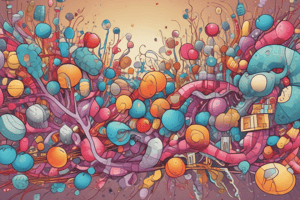Podcast
Questions and Answers
Why is antibiotic resistance considered a significant public health challenge?
Why is antibiotic resistance considered a significant public health challenge?
- Due to the increasing number of bacteria that can survive antibiotic treatment. (correct)
- Because patients are refusing to take antibiotics.
- Due to the overuse of vaccines.
- Because antibiotics are becoming more expensive.
How do antibiotics like kanamycin and streptomycin inhibit protein synthesis in bacteria?
How do antibiotics like kanamycin and streptomycin inhibit protein synthesis in bacteria?
- By strengthening the bacterial cell wall.
- By preventing transcription.
- By binding to bacterial ribosomes and preventing translation. (correct)
- By modifying the bacterial DNA directly.
What is the primary function of the red fluorescent protein (RFP) in the context of the BioBits® experiment?
What is the primary function of the red fluorescent protein (RFP) in the context of the BioBits® experiment?
- To strengthen the bacterial cell wall.
- To visually indicate successful protein synthesis. (correct)
- To degrade the antibiotics used in the experiment.
- To modify the antibiotic resistance gene.
Which of the following mechanisms is NOT a common way bacteria resist antibiotics?
Which of the following mechanisms is NOT a common way bacteria resist antibiotics?
What is the role of antibiotic resistance genes in bacteria?
What is the role of antibiotic resistance genes in bacteria?
Why is understanding the structural differences between bacterial and eukaryotic ribosomes important in developing new antibiotics?
Why is understanding the structural differences between bacterial and eukaryotic ribosomes important in developing new antibiotics?
How does horizontal gene transfer contribute to the spread of antibiotic resistance?
How does horizontal gene transfer contribute to the spread of antibiotic resistance?
In the context of the lab experiment, what is the expected outcome when susceptible bacteria are exposed to antibiotics?
In the context of the lab experiment, what is the expected outcome when susceptible bacteria are exposed to antibiotics?
Which bacterial process is directly disrupted by antibiotics that inhibit translation?
Which bacterial process is directly disrupted by antibiotics that inhibit translation?
What is the primary advantage of using BioBits® in the lab to study antibiotic effects?
What is the primary advantage of using BioBits® in the lab to study antibiotic effects?
Which of the following is a key characteristic of antibiotics that target bacterial cell walls?
Which of the following is a key characteristic of antibiotics that target bacterial cell walls?
What does the presence of kinase DNA in the experiment predict about translation in the presence of antibiotics?
What does the presence of kinase DNA in the experiment predict about translation in the presence of antibiotics?
Which of the following is NOT a typical target of antibiotics in bacterial cells?
Which of the following is NOT a typical target of antibiotics in bacterial cells?
What is the purpose of monitoring and controlling antibiotic use?
What is the purpose of monitoring and controlling antibiotic use?
What is the role of ribosomes in protein synthesis?
What is the role of ribosomes in protein synthesis?
How do bacteria typically acquire antibiotic resistance genes?
How do bacteria typically acquire antibiotic resistance genes?
Which of the following best describes the mechanism of action of aminoglycoside antibiotics?
Which of the following best describes the mechanism of action of aminoglycoside antibiotics?
Why is the selectivity of antibiotics important for treating bacterial infections in humans?
Why is the selectivity of antibiotics important for treating bacterial infections in humans?
What is the primary reason that antibiotic resistance poses significant challenges in clinical settings?
What is the primary reason that antibiotic resistance poses significant challenges in clinical settings?
What is the role of kinase proteins, encoded by resistance genes, in bacterial resistance to aminoglycoside antibiotics?
What is the role of kinase proteins, encoded by resistance genes, in bacterial resistance to aminoglycoside antibiotics?
Before conducting the experiment, predictions are made regarding the presence of various components in each tube. What are these predictions based on?
Before conducting the experiment, predictions are made regarding the presence of various components in each tube. What are these predictions based on?
In the context of antibiotic resistance, what is meant by the term "active efflux"?
In the context of antibiotic resistance, what is meant by the term "active efflux"?
What is a key strategy to combat antibiotic resistance?
What is a key strategy to combat antibiotic resistance?
During data collection in the experiment, what information is recorded from the tubes at specified time intervals?
During data collection in the experiment, what information is recorded from the tubes at specified time intervals?
Why is it important to gather information on the color of fluorescence during data collection?
Why is it important to gather information on the color of fluorescence during data collection?
Flashcards
Antibiotic Resistance
Antibiotic Resistance
The ability of bacteria to survive exposure to antibiotics that once killed them or inhibited their growth.
Antibiotics
Antibiotics
Small chemical molecules that target bacterial functions, disrupting essential processes like translation.
Antibiotic Resistance Genes
Antibiotic Resistance Genes
Segments of DNA that encode proteins enabling bacteria to survive antibiotic exposure.
Translation
Translation
Signup and view all the flashcards
BioBits®
BioBits®
Signup and view all the flashcards
Red Fluorescent Protein (RFP)
Red Fluorescent Protein (RFP)
Signup and view all the flashcards
Kanamycin and Streptomycin
Kanamycin and Streptomycin
Signup and view all the flashcards
Resistance Gene Action
Resistance Gene Action
Signup and view all the flashcards
Horizontal Gene Transfer
Horizontal Gene Transfer
Signup and view all the flashcards
Bacterial Cell Wall
Bacterial Cell Wall
Signup and view all the flashcards
Antibiotic resistance
Antibiotic resistance
Signup and view all the flashcards
Resistance proteins
Resistance proteins
Signup and view all the flashcards
Horizontal gene transfer
Horizontal gene transfer
Signup and view all the flashcards
Unique bacterial structures
Unique bacterial structures
Signup and view all the flashcards
Cell wall synthesis
Cell wall synthesis
Signup and view all the flashcards
Role of Ribosomes
Role of Ribosomes
Signup and view all the flashcards
Action of antibiotics
Action of antibiotics
Signup and view all the flashcards
Resistance genes
Resistance genes
Signup and view all the flashcards
Resistance mechanisms
Resistance mechanisms
Signup and view all the flashcards
Resistant genes
Resistant genes
Signup and view all the flashcards
Study Notes
- Antibiotic resistance poses a major public health crisis due to increasing instances of bacteria surviving antibiotic treatments.
- Over one million deaths occur annually from antibiotic-resistant bacterial infections, underscoring the urgency of the issue.
- Antibiotics are vital for treating bacterial infections by targeting bacterial functions without harming human cells.
- Antibiotics disrupt cellular processes, especially translation, essential for protein synthesis.
Mechanisms of Antibiotic Resistance
- Bacteria resist antibiotics by evading their effects through mechanisms that target specific antibiotics or drug classes.
- Resistance mechanisms include chemical modification of antibiotics and active efflux, where bacteria pump out the antibiotic.
- Antibiotic resistance genes are DNA segments encoding proteins that enable bacteria to survive antibiotic exposure.
Understanding Protein Synthesis
- Translation, the process by which ribosomes synthesize proteins using mRNA, is crucial for cellular function.
- Antibiotics disrupting translation prevent bacteria from producing essential proteins, leading to cell death.
- BioBits is a cell-free protein synthesis system mimicking bacterial protein synthesis in vitro, allowing observation of antibiotic effects without live bacterial cultures.
- The system employs DNA instructions to produce proteins, like the red fluorescent protein (RFP), indicating successful translation.
Experimental Design and Objectives
- Experiments aim to characterize an antibiotic resistance gene and two antibiotics to understand their mechanisms of action.
- These experiments also help confirm antibiotics block translation and identify which antibiotic is affected by the resistance gene.
- Red fluorescence of RFP serves as a visual indicator of successful protein synthesis in the presence of antibiotics.
- Susceptible bacteria will stop dividing and die with antibiotics, while resistant bacteria will thrive.
- These experiments provide insights into studying antibiotic resistance without traditional culturing methods, enhancing understanding of bacterial survival.
Overview of Protein Synthesis and Antibiotics
- Protein synthesis involves transcription and translation, where DNA is converted into proteins.
- Ribosomes are important in translation, essential for facilitating the assembly of amino acids into proteins.
- Disruption of protein synthesis can occur from antibiotics, targetting stages of protein synthesis.
- The red fluorescent protein (RFP) indicates that translation has occurred successfully.
- Kanamycin and streptomycin inhibit protein synthesis by binding to bacterial ribosomes and preventing translation.
- These antibiotics are aminoglycosides and are effective against bacteria.
- The mechanism of action involves interference with the ribosomal function, leading to cell death.
- Antibiotic resistance genes, such as those encoding aminoglycoside kinases, can provide bacteria with the ability to survive aminoglycosides.
- Resistance mechanisms involve the modification of the antibiotic or target site, rendering the antibiotic ineffective.
Experimental Design and Predictions
- Experiments aim to test whether kinase DNA can confer resistance to kanamycin or streptomycin.
- The presence of kinase DNA is expected to allow continued translation in the presence of antibiotics, indicated by RFP fluorescence.
- Prediction outcomes are based on the presence of Biobits, kinase DNA, antibiotics, and RFP DNA.
- The predictions are based on how antibiotics interact with ribosomes and the role of resistance genes.
- Fluorescence observations after the experiment will help confirm or refute the predictions made.
- The results will provide insights into the effectiveness of the kinase gene in conferring antibiotic resistance.
Mechanisms of Antibiotic Resistance
- Antibiotic resistance occurs when bacteria evolve mechanisms to resist the effects of drugs that once killed them or inhibited their growth.
- Resistance genes often encode proteins that can modify or degrade the antibiotic, preventing it from exerting its effects.
- Horizontal gene transfer can spread resistance genes among bacterial populations, complicating treatment options.
- Antibiotic resistance genes pose a challenge in clinical settings, leading to treatment failures.
- Resistance can be combatted through the development of antibiotics and combination therapies.
- Monitoring and controlling antibiotic use is essential to slow the spread of resistance.
Targeting Bacterial Structures
- Antibiotics often target unique bacterial structures, such as the cell wall, which are not present in human cells.
- Disrupting cell wall synthesis leads to bacterial lysis and death, making it an effective target for antibiotics.
- Selectivityis crucial for minimizing toxicity to human cells while effectively treating bacterial infections.
- Differences in ribosomal structure between bacteria and eukaryotes allow for selective targeting of bacterial ribosomes by certain antibiotics.
- Understanding these structural differences is key to developing antibiotics that are effective against bacteria without harming human cells.
Experimental Observations and Data Analysis
- Data from the experiment includes the presence or absence of fluorescence in each tube at specified time intervals.
- Observations will be recorded for both kanamycin and streptomycin treatments, noting any changes in fluorescence over time.
- The color of fluorescence will also be documented, providing additional information on the success of translation.
- Analyzing the data will help determine the effectiveness of the kinase gene in conferring resistance to the antibiotics used.
- The results will be compared against predictions made prior to the experiment to assess the accuracy of the hypotheses.
- Understanding the outcomes is important for the broader knowledge of antibiotic resistance mechanisms.
Studying That Suits You
Use AI to generate personalized quizzes and flashcards to suit your learning preferences.




